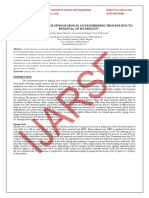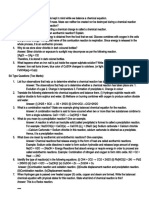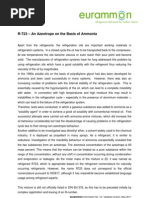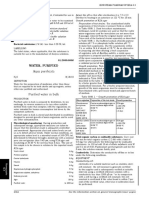I. Storage Guidelines and Redrying: Storing Stic Electrodes
I. Storage Guidelines and Redrying: Storing Stic Electrodes
Uploaded by
Mohammad ganiCopyright:
Available Formats
I. Storage Guidelines and Redrying: Storing Stic Electrodes
I. Storage Guidelines and Redrying: Storing Stic Electrodes
Uploaded by
Mohammad ganiOriginal Description:
Original Title
Copyright
Available Formats
Share this document
Did you find this document useful?
Is this content inappropriate?
Copyright:
Available Formats
I. Storage Guidelines and Redrying: Storing Stic Electrodes
I. Storage Guidelines and Redrying: Storing Stic Electrodes
Uploaded by
Mohammad ganiCopyright:
Available Formats
I.
Storage guidelines and redrying
Storing stic electrodes
Covered electrodes should always be stored in their original packaging until they are used.
Electrode packages should, as far as possible, be removed on first-in fist out basis.
Stick electrodes must be stored in dry rooms in order to protect them from moisture damage.
The storage are should therefore be protected against the weather and ventilated. Ceilings,
floors and walls must be dry, and there must be no open water surfaces in the room. The room
must be fitted with pallets or with shelving, since storage directly on the floor or against the
walls is not recommended.
Electrode packages that have been opened must be stored in dry rooms, which may have to
be heated to avoid falling below the dew point.
edrying and processing electrodes
It is recommended that any electrodes that have become damp or that have not been properly
stored are redried according to the temperatures given in the following table immediately befo-
re welding. Following this it is in any case recommended to weld from a quiver heated to 100-
150 C in order to be able to maintain the lowest possible hydrogen content.
Stick electrodes for ... Covering type Redrying Redrying Redrying time
recommended temperature in C in hours
nalloyed and , R, C, RC, No -- --
low-alloy steels R, RR, R
es 300 350 2 10
igh-strength fine-grained es 300 350 2 10
structural steels
Creep-resistant steels R No -- --
36 R , es 300 350 2 10
Stainless and R If necessary 120 200 2 10
heat-resistant steels R , No -- --
Soft martensitic steels es 300 350 2 10
uplex steels R es 250 300 2 10
Nickel alloys R, If necessary 120 300 2 10
The redrying temperature is also quoted on the labels of the hler packages.
The following procedure is helpful for redrying electrodes
Ī The electrodes should be placed in a pre-heated furnace approx. 80 - 100 C
layers should not be more than three.
Ī Once heated up, the recommended temperature should be maintained for about
2 hours. If the redrying temperature is above 250 C, the temperature should be raised
to the recommended value slowly approx. 150 C/hour .
Ī total redrying time i.e. the total of the times of individual redrying procedures of more
than 10 hours should not be exceeded. This maximum time must also be observed if
the redrying is carried out in a number of cycles.
Ī The temperature should be lowered to between 100 and 150 C before removing from
the furnace.
Electrodes that have been in direct contact with water, grease or oil should not be used. In
such cases, even redrying does not provide an adequate solution.
Covered electrodes that are delivered in undamaged boxes or in vacuum packaging do not
require redrying if they are put immediately into a heated quiver and used from there.
Electrodes from damaged boxes or vacuum packaging must be treated according to the spe-
cifications.
Filler Metals Bestseller for Joining Applications
I. Storage guidelines and redrying
Stick electrodes for which redrying is not recommended in the table above may, in some indi-
vidual cases, still benefit from redrying. This can be the case if storage was inappropriate, or
as a result of other conditions that lead to an excessive water content. The high water content
can often be recognised from increased spraying or pore formation during welding. In these
cases, the stick electrodes can unless otherwise specified by the manufacturer be redried
for about one hour at 100 - 120 C. This recommendation does not apply to cellulose-covered
electrodes, which must never be redried.
The temperature for intermediate storage in a furnace after redrying should be between 120
and 200 C maximum total storage time 30 days , or, if stored in quivers, between 100 and
200 C maximum storage time 10 days .
Storage of flux cored wires
The risk of moisture absorption is not as great with flux cored wires as it is for stick electro-
des. The core is shielded from the ambient atmosphere to a large extent by the metal surro-
und. Nevertheless, the low-hydrogen character of a flux cored wire can be impaired by long
contact with moist air. This can, for instance, happen through unprotected storage overnight
in a high-humidity environment.
Flux cored wire should be kept in storage facilities where the temperature and humidity con-
ditions are controlled. We recommend the use of dry rooms, possibly heated, to avoid falling
below the dew point. The aim should be a maximum 60 relative air humidity and a minimum
temperature of 15 C.
If stored below 10 C there is a risk that water will condense on the surface of the wire when
the package is opened in heated rooms. This can lead to pore and gas impressions on the
welded seam when welding starts.
Welding should only be done with acclimatised wires.
When welding has finished, the spool with the remaining wire should be removed from the 37
machine and placed back in the original packaging the compound aluminium foil should be
closed again as far as possible. It is also possible to use a box such as is used for deliveries
of hler welding flux for high-alloy steels.
edrying flux cored wires
Redrying is not required as a rule. If, in some exceptional case, redrying is needed, this can
be done at 150 C for 24h.
Storage and redrying of welding flux
It is recommended that welding flux is stored in the driest possible conditions and at the most
even possible temperature, in order to keep water absorption during storage as low as possi-
ble. nder these conditions, fluxes can generally be kept for up to three years. Flux from con-
tainers that have been damaged during transport must either be used immediately or put into
new packaging. In order to ensure crack-free welding, fluoride-basic fluxes should be redried
prior to use. Fluxes that are taken directly from airtight, sealed, undamaged metal sheet con-
tainers do not have to be redried.
Type of flux manufacture Flux type Redrying Redrying Redrying time
recommended temperature in C in hours
gglomerated F es ca. 350 2 - 10
R es ca. 300 2 - 10
elted S es ca. 150 2 - 500
The drying temperatures and times given in the above table should be considered as a gene-
ral guideline. fter redrying, welding flux that is not being used immediately is to be stored at
150 C until used for welding. The intermediate storage period should not exceed 30 days.
The furnace used for the redrying must not permit any local overheating of the flux, and must
be adequately ventilated. If drying is stationary, the flux layer should not be thicker than
50 mm.
Filler Metals Bestseller for Joining Applications
You might also like
- Msds Parfum Zara NewDocument6 pagesMsds Parfum Zara NewDiorama Bali100% (2)
- A Complete Guide to Watch Repair - Barrels, Fuses, Mainsprings, Balance Springs, Pivots, Depths, Train Wheels and Common Stoppages of WatchesFrom EverandA Complete Guide to Watch Repair - Barrels, Fuses, Mainsprings, Balance Springs, Pivots, Depths, Train Wheels and Common Stoppages of WatchesRating: 4 out of 5 stars4/5 (1)
- Sponge IronDocument15 pagesSponge IronMOHNISHKUMARJHA100% (1)
- 2018 Handling and Storage Recommendations - EN - Rev1!02!2018Document4 pages2018 Handling and Storage Recommendations - EN - Rev1!02!2018David Hortas CasasNo ratings yet
- COR Handling+and+Storage+Recommendations EN Rev2 2018 GL 1003 PreviewDocument4 pagesCOR Handling+and+Storage+Recommendations EN Rev2 2018 GL 1003 PreviewAli AliNo ratings yet
- 431 Martensitic Stainless Steel BarDocument4 pages431 Martensitic Stainless Steel Barzulu80No ratings yet
- EN26Document3 pagesEN26Moldoveanu TeodorNo ratings yet
- ESAB Electrodes User ManualDocument44 pagesESAB Electrodes User ManualF. Alijani100% (1)
- Interlloy 440C MartensiticDocument4 pagesInterlloy 440C MartensiticGuillaume BoyerNo ratings yet
- SG Materials Selection SS 316Document4 pagesSG Materials Selection SS 316rkukgNo ratings yet
- ŠamotDocument1 pageŠamotDinko BrezakNo ratings yet
- Pressure Part Materials Its Service TemperatureDocument4 pagesPressure Part Materials Its Service TemperatureAkil PrabhuNo ratings yet
- Spring SteelDocument2 pagesSpring Steelvaishu1502No ratings yet
- Strip Heater Technical CatalogueDocument8 pagesStrip Heater Technical CataloguechikoopandaNo ratings yet
- Insulating Materials PDFDocument11 pagesInsulating Materials PDFmozkarakocNo ratings yet
- Alloy 330 Spec SheetDocument2 pagesAlloy 330 Spec SheetAA.KarandishNo ratings yet
- 8620 Case Hardening SteelDocument3 pages8620 Case Hardening Steelkumarsathish2009No ratings yet
- Bright Annealing: Technical Data SheetDocument6 pagesBright Annealing: Technical Data Sheetkutts76No ratings yet
- Al6XN AlloyDocument10 pagesAl6XN AlloyTommaso Di GiamberardinoNo ratings yet
- HT GuideDocument26 pagesHT Guidejoeajay.alphonseNo ratings yet
- Carpenter Stainless Custom 630 PDFDocument9 pagesCarpenter Stainless Custom 630 PDFGrafton MontgomeryNo ratings yet
- 570 950mpa High Tensile Strength SteelDocument32 pages570 950mpa High Tensile Strength SteelCarlos PadillaNo ratings yet
- Storage Handling Recommendations For ConDocument7 pagesStorage Handling Recommendations For ConAmir Reza RashidfarokhiNo ratings yet
- Storing and Re-Drying Electrodes: Save On DiscountedDocument2 pagesStoring and Re-Drying Electrodes: Save On DiscountedRama Krishna Reddy DonthireddyNo ratings yet
- Hoja de Especificaciones Del Acero T-410Document2 pagesHoja de Especificaciones Del Acero T-410cristobal_tl2277No ratings yet
- Electrode BakingDocument3 pagesElectrode BakingMadhan RamamoorthyNo ratings yet
- ELECRODE STORAGeDocument4 pagesELECRODE STORAGeGuruchell ChellguruNo ratings yet
- Dasar Pemilihan MaterialDocument7 pagesDasar Pemilihan MaterialjizanNo ratings yet
- EN 1 4835 - 1510 Valbruna Nordic EnglishDocument2 pagesEN 1 4835 - 1510 Valbruna Nordic Englishnguyenhuutan91No ratings yet
- P20 Tool Steel-Welding-Spec PDFDocument8 pagesP20 Tool Steel-Welding-Spec PDFMICKENo ratings yet
- 1.4006 en PDFDocument2 pages1.4006 en PDFdiego.peinado8856No ratings yet
- D3 Wys PDFDocument3 pagesD3 Wys PDFEdilson Sarmiento AlonsoNo ratings yet
- Sirius 314: A 25% CR - 1.8 % Si Heat Resistant Stainless SteelDocument4 pagesSirius 314: A 25% CR - 1.8 % Si Heat Resistant Stainless SteelVíctor SandovskyNo ratings yet
- Indian Institute of Welding - ANB Refresher Course - Module 07Document55 pagesIndian Institute of Welding - ANB Refresher Course - Module 07dayalram0% (1)
- Corrosion Guide - Stainless Internation NickelDocument20 pagesCorrosion Guide - Stainless Internation NickelJohn BurkeNo ratings yet
- High Temperature Stainless Steel EN 1.4835 - UNS S 30815 - 253 MA®Document2 pagesHigh Temperature Stainless Steel EN 1.4835 - UNS S 30815 - 253 MA®ivanoliveira3261No ratings yet
- Boiler MaterialsDocument5 pagesBoiler MaterialsRavi ShankarNo ratings yet
- Electrode Storage GuidelinesDocument2 pagesElectrode Storage GuidelinesAnonymous L0ChmPGNo ratings yet
- HighTens AISI4340Document2 pagesHighTens AISI4340wellengineerNo ratings yet
- Metal Characteristics Part 2Document48 pagesMetal Characteristics Part 2Ali RayyaNo ratings yet
- BIBUS METALS Land Based Gas Turbines LowResDocument2 pagesBIBUS METALS Land Based Gas Turbines LowResMahsaNo ratings yet
- 1973 BACKER Shaped Heat 20111009Document50 pages1973 BACKER Shaped Heat 20111009Hank MarvinNo ratings yet
- Welding Metallurgy of Titanium AlloysDocument46 pagesWelding Metallurgy of Titanium AlloysBaraneedharanNo ratings yet
- Aisi H13Document2 pagesAisi H13123vigenNo ratings yet
- Thermowell Material SelectionDocument3 pagesThermowell Material SelectionJp NairNo ratings yet
- Datasheet-Sandvik-253-Ma-En-V2021-04-22 18 - 36 Version 1Document12 pagesDatasheet-Sandvik-253-Ma-En-V2021-04-22 18 - 36 Version 1FilipNo ratings yet
- Gold Tin - The Unique Eutectic Solder AlloyDocument2 pagesGold Tin - The Unique Eutectic Solder AlloyJackFlash31No ratings yet
- High Tensile Steel - Aisi 4140Document2 pagesHigh Tensile Steel - Aisi 4140tetirichieNo ratings yet
- Duplex Stainless Steel Part 1Document2 pagesDuplex Stainless Steel Part 1aviant_gardNo ratings yet
- Duplex Stainless Steel 329 or 1.4460 PDFDocument2 pagesDuplex Stainless Steel 329 or 1.4460 PDFtien100% (1)
- Web Upload - Welding Rod Control ProcedureDocument2 pagesWeb Upload - Welding Rod Control Procedureinfo2613No ratings yet
- Grade 91 R 10-05 PDFDocument5 pagesGrade 91 R 10-05 PDFSarveshNo ratings yet
- Aluminium 1100Document2 pagesAluminium 1100Anup DalalNo ratings yet
- Patented Nov. 6, 1945: C Crime. (Or. New-21.1)Document3 pagesPatented Nov. 6, 1945: C Crime. (Or. New-21.1)Sri PupNo ratings yet
- Secondary Steel Making and Steel CastingDocument16 pagesSecondary Steel Making and Steel Castingritoce8668No ratings yet
- Astralloy-V: Abrasion and Impact Resistant, Air Hardened Wear SteelDocument2 pagesAstralloy-V: Abrasion and Impact Resistant, Air Hardened Wear SteelJRodengineerNo ratings yet
- Boiler Making for Boiler Makers - A Practical Treatise on Work in the ShopFrom EverandBoiler Making for Boiler Makers - A Practical Treatise on Work in the ShopRating: 4.5 out of 5 stars4.5/5 (2)
- Transactions of the American Society of Civil Engineers, vol. LXX, Dec. 1910 Tests of Creosoted Timber, Paper No. 1168From EverandTransactions of the American Society of Civil Engineers, vol. LXX, Dec. 1910 Tests of Creosoted Timber, Paper No. 1168No ratings yet
- Blacksmithing on the Farm - With Information on the Materials, Tools and Methods of the BlacksmithFrom EverandBlacksmithing on the Farm - With Information on the Materials, Tools and Methods of the BlacksmithNo ratings yet
- Soldering Electronic Components 2nd EditionFrom EverandSoldering Electronic Components 2nd EditionRating: 3 out of 5 stars3/5 (2)
- Ch. 14 Organic Chemistry 9Document30 pagesCh. 14 Organic Chemistry 9Swara TendulkarNo ratings yet
- 22PRECISE - ADVANCED - LEVEL - CHEMISTRY - PRACTICAL - GUIDE - PDF - Titration - PH PDFDocument52 pages22PRECISE - ADVANCED - LEVEL - CHEMISTRY - PRACTICAL - GUIDE - PDF - Titration - PH PDFAmadiNo ratings yet
- Synthesis of 1 Phenylazo 2 Naphthol RDRDocument2 pagesSynthesis of 1 Phenylazo 2 Naphthol RDRNashDanielSilavaNo ratings yet
- VSA Type QuestionsDocument7 pagesVSA Type QuestionsTapas BanerjeeNo ratings yet
- Water Requirements, Volvo CoolantsDocument1 pageWater Requirements, Volvo CoolantsCesar BlancoNo ratings yet
- R-723 - An Azeotrope On The Basis of AmmoniaDocument6 pagesR-723 - An Azeotrope On The Basis of AmmoniaevrimkNo ratings yet
- Mini Project Full PDFDocument37 pagesMini Project Full PDFMohamad El KheirNo ratings yet
- Agua BPDocument3 pagesAgua BPEdgar Condori MendozaNo ratings yet
- Licensed Polyolefin Technologies and Services: SpherizoneDocument2 pagesLicensed Polyolefin Technologies and Services: SpherizoneTVCNo ratings yet
- Coconut Oil Uses As Diesel FuelDocument6 pagesCoconut Oil Uses As Diesel Fueldavid_tomy_1No ratings yet
- Global WarmingDocument50 pagesGlobal WarmingLeah Oljol RualesNo ratings yet
- Degumming Palm Kernel PDFDocument6 pagesDegumming Palm Kernel PDFAmanda EdwinNo ratings yet
- Enzyme Catalysis Lab ReportDocument3 pagesEnzyme Catalysis Lab ReportJennifer PutmanNo ratings yet
- Alum 1 PDFDocument6 pagesAlum 1 PDFSavaNo ratings yet
- PDS e-BE 1.0 (Bioethanol)Document1 pagePDS e-BE 1.0 (Bioethanol)Bambang Eko Teguh wNo ratings yet
- BigMint Newsletter 09-10-2024 (1)Document9 pagesBigMint Newsletter 09-10-2024 (1)Avinash SrivastavaNo ratings yet
- L7-2 Heavy Metal PollutionDocument18 pagesL7-2 Heavy Metal PollutionRamlahBegumUmerkuttyNo ratings yet
- TDS CPE CF112 CarbonDocument1 pageTDS CPE CF112 CarbonDiego I. Rozada BarchiesiNo ratings yet
- 2K25 SIRKACADEMY CHEMISTRY MOCK TESTDocument3 pages2K25 SIRKACADEMY CHEMISTRY MOCK TESTVictorNo ratings yet
- Lab 19: Properties of Buffer Solutions: Driving QuestionDocument12 pagesLab 19: Properties of Buffer Solutions: Driving QuestionyuvaraajaNo ratings yet
- Co2 O2 Table - 2012 PDFDocument5 pagesCo2 O2 Table - 2012 PDFIgor LainovicNo ratings yet
- Worksheet ElectroChemistry-2Document2 pagesWorksheet ElectroChemistry-2Rishi ChatterjeeNo ratings yet
- wch16 01 Rms 20240307Document25 pageswch16 01 Rms 20240307layaungthar layaungNo ratings yet
- Transition Metal BasicsDocument40 pagesTransition Metal BasicsongyewshenNo ratings yet
- FirePro Xtinguish V1.03Document99 pagesFirePro Xtinguish V1.03احمد الجزار2007100% (2)
- Alkaline Surfactant Polymer in AlbertaDocument35 pagesAlkaline Surfactant Polymer in AlbertaRasesh Saraiya100% (1)
- Evaluation of Agricultural LimestoneDocument2 pagesEvaluation of Agricultural LimestonesoumyaNo ratings yet
- 2 - AIChE Journal, Vol. 51, No. 11, (November 2005) PDFDocument204 pages2 - AIChE Journal, Vol. 51, No. 11, (November 2005) PDFRodrigo CastroNo ratings yet

























































































